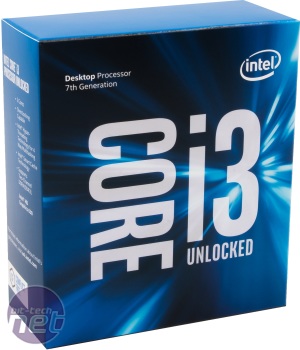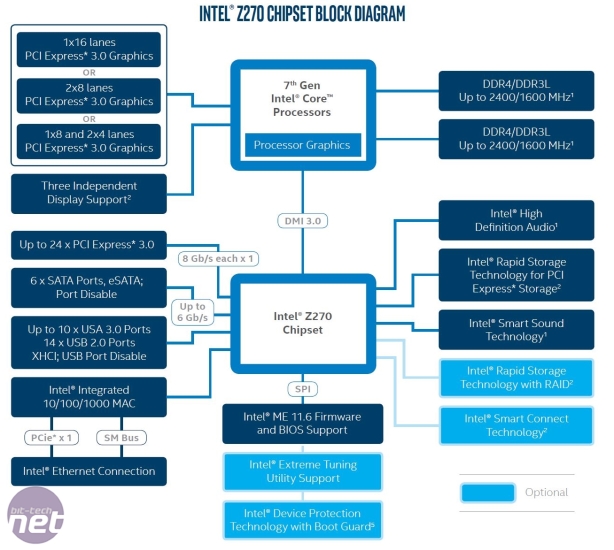Intel Core i7-7700K, Core i5-7600K (Kaby Lake) and Z270 Chipset Review
January 3, 2017 | 16:59
Companies: #bit-tech

Intel Core i3-7350K
Of all the new bits we're looking at today, perhaps the most interesting is the Core i3-7350K, although you'll have to wait just a little longer for the full review of that part. As its name suggests, we're dealing with an unlocked Core i3, and with a price of $168 compared to $242 for the Core i5-7600K, you're saving over $80, which will translate into some sizeable savings in sterling too when the CPU is released later this month. The key factor here, apart from the price of course, is that the Core i3-7350K supports hyper-threading. The Pentium G3258 Anniversary Edition CPU, which was the last sub-Core i5 CPU to officially support overclocking via an unlocked multiplier back with Devil's Canyon, lacked this.Being a dual-core, you were thus stuck with two threads and the repercussions were obvious - poor performance anywhere that multi-threading counted. Sure, you could overclock it by over 1,500MHz, but as you can see in our review, there are several situations where a hyper-threaded Core i3 gave it a run for its money, even with the Pentium overclocked 1,500MHz higher. It's also the case that some games saw performance dips too.
| Cores/threads | Base Freq | L3 Cache | TDP | Price | |
| Pentium G3258 | 2/2 | 3.2GHz | 3MB | 53W | $75/£53 |
| Core i3-7350K | 2/4 | 4.2GHz | 4MB | 60W | $168/£150 |
 We're not talking about the bargain of the century here - the Core i3-7350K still retails for around $168/£150, according to Intel. That's actually the same price you'd have paid for an Intel Core i5-760 quad-core and only £20 less than the likes of the Core i5-2500K and Core i5-3570K. It's also clear that given the most expensive non K-edition Core i3 costs around $20 less, Intel isn't daft - it's applying the same price bump you'd expect given the K-series name. However, it's still a sizeable amount less than the Core i5-7600K, and, more importantly, look at those specifications above.
We're not talking about the bargain of the century here - the Core i3-7350K still retails for around $168/£150, according to Intel. That's actually the same price you'd have paid for an Intel Core i5-760 quad-core and only £20 less than the likes of the Core i5-2500K and Core i5-3570K. It's also clear that given the most expensive non K-edition Core i3 costs around $20 less, Intel isn't daft - it's applying the same price bump you'd expect given the K-series name. However, it's still a sizeable amount less than the Core i5-7600K, and, more importantly, look at those specifications above.We're not talking about some lowly dual-core here. The Core i3-7350K has a base clock of a lofty 4.2GHz, has four threads not two, will likely overclock further than the Pentium G3258 in addition to sporting increased IPC and a 33 percent bigger L3 cache at 4MB versus 3MB. The TDP is only 7W more too - in everything but price, this is a vastly superior CPU across the board and could well be a fantastic option for a budget system - the extra two threads won't be as potent as a true quad-core, but they'll definitely help to bridge that multi-threaded performance gap.
Not only this, but the Core i3-7350K should help bring fresh blood into the enthusiast market as those that are typically younger with more restricted budgets look to get into overclocking and building their own PCs. This is a great move by Intel, and the price is actually cleverly set. Anyone wanting a high-end system would go for the i5 or i7, with just a select few considering the i3 or i5. For the latter group, they now have the option of overclocking whereas before, if they couldn't stretch to a Core i5 K-Edition, there was little point opting for a high-end motherboard or other hardware. There's also a strong case for motherboards of the Z270 flavour to be offered below £100 too - we'll hopefully be looking at some soon.
Z270 Chipset
There's been no change in terms of overclocking - you'll need a Z270 motherboard in order to tweak the multiplier on the unlocked Core i3, i5 and i7 CPUs. There's not much change elsewhere either. USB 3.1 (Gen 2) support is not native, so motherboards will either need an Intel or ASMedia controller to provide corresponding Type-A or Type-C ports as well as Thunderbolt 3 support (Intel controller only). You get the same number of SATA 6Gbps ports (six), the same number of USB 3.0 ports (10) and support for three independent displays as standard.The key area of difference, apart from Intel Optane support, is the total number of PCI-Express 3.0 lanes. This has risen from 20 with Z170 to 24 with Z270, providing an additional 32Gb/sec bandwidth. With rumours that Intel may offer a small Optane SSD purely for its supposed caching feature and most premium Z270 motherboards we've seen offering at least two PCI-E x4 M.2 ports, with some even sporting three, it's clear that Intel has focussed on improved support for multiple ultra-fast SSDs, maybe even for the ability to use its or another manufacturer's M.2 SSD alongside a smaller one specifically for caching with Optane.
Sadly, the extra PCI-E lanes can't be fed into the 16x PCI-E slots - you'll need to opt for an X99 system to see more than eight lanes per slot in dual-GPU setups, but while this may seem like a very minor addition, the extra lanes for storage may be tempting for high-end users given how much faster and more affordable PCI-E based M.2 SSDs are at the moment.

MSI MPG Velox 100R Chassis Review
October 14 2021 | 15:04










Want to comment? Please log in.